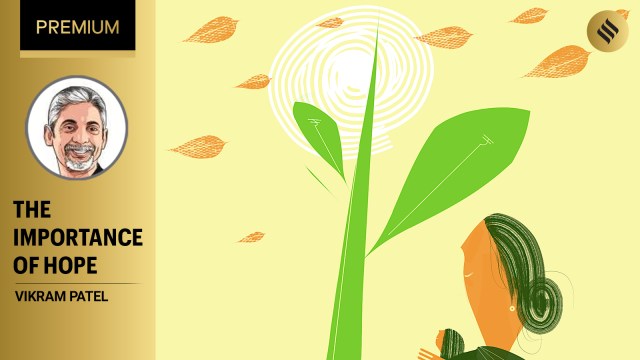Why the young don’t want to have children— and how to fix that
There is growing evidence that they do not want to bring children into a world whose very survival is threatened by climate change, even as the global community fails to take the needed action
 A hopeful future lies in a more equal and compassionate country — this can be realised through progressive taxation, bolstering labour and social security, pension laws, and parental and retirement benefits. (Illustration by CR Sasikumar)
A hopeful future lies in a more equal and compassionate country — this can be realised through progressive taxation, bolstering labour and social security, pension laws, and parental and retirement benefits. (Illustration by CR Sasikumar)Not so long ago, we were fed with terrifying projections of a population “time bomb” which would overwhelm our country, and the world, depleting all its resources and leaving everyone impoverished. We were exhorted to trim our family size for the sake of the country — no more than two children and just one would be truly patriotic. China went further: Those who had more than one child were subjected to shame and stiff penalties. It is remarkable how the narrative has flipped.
The publication of a paper on global population trends in the Lancet last week is only the latest to project that the population “time bomb” staring us in the face is in the exact opposite direction. Now, it appears that the world’s population is likely to shrink precipitously in most countries, including India. China is projected to lose up to half its current population by 2100. Only sub-Saharan Africa will buck this trend — in this not-too-distant future, one in two children born in the world will be African, ironically much like our remote past when people from the continent dominated our planet.
Of course, many of us will not live long enough to experience this shrinking world. We must also pause for a moment to acknowledge that all modelled estimates of population are based on assumptions which do not account for unexpected shifts in social norms, such as those that have led to reductions in the estimated number of people on our planet in the future. So, the best way to interpret these estimates is as a warning that, if we don’t do anything to understand and address the factors behind declining fertility, populations are going to shrink. This is alarming primarily because the losses will be entirely due to fewer births. This, in turn, paints a dystopic picture — a world increasingly populated by old people. Neighbourhoods, once filled with the laughter of kids playing could now be dominated by the staccato of walking sticks. And who will then support the legions of older people who are not only less productive but also in greater need of health and social care resources?
There are many theories about why fertility is falling, even in countries where religion frowns upon contraception. A common theory is that education and women’s empowerment are key factors, along with the increasing probability of child survival. This theory argues that, as women have greater agency and certainty about the survival of their children, they opt for smaller families. But it fails to answer why so many women, and couples, are opting not to have any children at all. In many countries, such as the US, the largest changes in family size have not just been amongst those who have three or more children but also those who have zero children.
Another theory is that women and couples are opting not to have children because of workplace policies that deny them job security and income support to enjoy parenthood, especially because the costs of child-rearing have increased in atomised societies where traditional support systems have evaporated. However, this theory fails to explain why fertility is falling even in wealthy countries, including those with the most generous parental policies. It does not explain why fertility is falling even amongst wealthier segments of the population who have no financial constraints. Indeed, a recent analysis found that the effects of pro-natal policies, such as childcare subsidies and extended parental leave and tax incentives, on fertility rates are very small.
I believe that the most important reason for declining fertility is that young people are intentionally choosing not to have children because they fear the state of the world their children would inherit. For example, there is growing evidence that young people do not want to bring children into a world whose very survival is threatened by climate change, even as the global community fails to take the needed action.
In India, several other headwinds, documented in a series of recent reports, are fuelling uncertainty. The India Employment Report 2024 describes the bleak scenario for young people: Nearly 90 per cent are informally employed, facing a future which offers no income security and low wages. The World Inequality Lab reports that in 2022-23, the richest one per cent of Indians had cornered 40 per cent of the wealth of the nation. Such an astonishing level of inequality, which is inimical to societal solidarity and connectedness, is unparalleled in our history. India was ranked 126th out of 143 nations in the World Happiness Report 2024, behind even Pakistan and the country’s youth were amongst the unhappiest of all. And, several international bodies have downgraded India’s democracy to being “partially free” or “flawed” or as an “electoral autocracy”.
Why would anyone want to start a family in such a bleak scenario?
That said, the demographic changes that are being predicted are not inevitable. Policies such as promoting women’s education have led to a reduction in fertility. Fertility too can be stabilised. To do so, in a nutshell, policies need to restore hope in young people. More immediately, policies need to be framed to not squander India’s much-vaunted demographic dividend of being home to the largest number of young people in the world.
A hopeful future lies in a more equal and compassionate country — this can be realised through progressive taxation, bolstering labour and social security, pension laws, and parental and retirement benefits. We should be prepared for the inevitable surge in the numbers of older people. A hopeful future is a more caring country, one where universal health coverage is truly universal and offers high-quality long-term care for persons living with chronic conditions.
A hopeful future is a more inclusive and dignified country, one which embraces its diversity and in which we can dissent with civility and fearlessly — features that seem to have been deeply damaged in the run-up to the elections. Our future generations will look back to this moment in history and ask if we, the people who knew what lies ahead did the right thing.
The writer is Paul Farmer Professor of Global Health at Harvard Medical School
- 01
- 02
- 03
- 04
- 05































